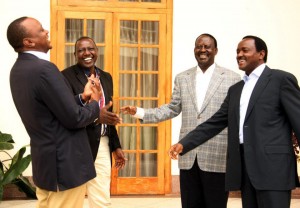Kenya goes for a repeat presidential election on October 26. The country conducted general elections on August 8, but the Supreme Court invalidated the presidential election in which the electoral commission (IEBC) had declared incumbent President Uhuru Kenyatta as the winner, and instead ordered a fresh election be done within sixty days.
August also saw two other major elections in Africa; On August 4, Rwandans re-elected President Paul Kagame as he was the choice of 99% of the nearly seven million voters. Meanwhile, in Angola, elections were held on August 23. President Jose dos Santos was not in the running as he was stepping down and they were won by João Lourenço, the Minister of Defense and Vice-President his party.
Elsewhere: Togo is to have a referendum on a bill that limits the term of the President; also a bill has been introduced in Uganda’s parliament to remove a 75-year age limit for the President (Yoweri Museveni is 73 now), and Liberia is to have an election on October 10 that will usher in a new President after Ellen Johnson-Sirleaf, who in 2005 became Africa’s first elected female leader,
The Institute of Chartered Accountants in England and Wales (ICAEW) published a report they did with advisory firm Oxford Economic on Africa economic insights for Q3 of 2017.
some excerpts
Kenya: The leaders who take office in Kenya after the October 26 presidential poll will need to reign in expenditure to improve the economy’s prospects according to ICAEW.
The report states that the new government will need to take a number of steps to revive the economy following the October 26th vote. A start would be to rethink the regulatory cap on commercial interest rates, which has starved small and medium enterprises of funding. Reining in expenditure, in order to ensure government debt does not get out of hand, would improve the economy’s future prospects. Furthermore, the newly elected government will need to lead the charge against corruption.
Rwanda: President Kagame’s re-election is expected to result in the continuation of business-friendly policies to boost entrepreneurship.
Tanzania: The operating environment in Tanzania is becoming increasingly complicated due to President Magafuli’s economic nationalism.
Ethiopia has lifted a state of emergency that was in place for 10 months, and there is a risk that social unrest may keep disrupting the state led development that has produced the country’s economic boom. Still, real GDP growth is forecast to come in at the very impressive rate of 7.1% in 2017.
Nigeria, & Angola: The two big oil producers, Nigeria and Angola, have continued to deal with the effects of a much lower oil price: foreign reserves are hard to come by, which complicates the operating environment for all firms, especially those that need imports. In both countries inflation is falling but still high, interest rates remain high and the governments have been cautious with their spending, meaning government expenditures have not contributed to the economy.
Ghana: Ghana’s continued participation in the International Monetary Fund (IMF) Extended Credit Facility (ECF) programme has been characterised by significant uncertainty ever since the New Patriotic Party (NPP) took the reins by defeating the National Democratic Congress (NDC) in the 2016 elections. Real GDP growth is expected to exceed 6% in 2017, driven by higher oil output and a recovery in consumer demand. International reserves also received a healthy boost due to robust foreign appetite for longer dated government securities. Finally, authorities have made significant progress with the implementation of the banking system roadmap. There are several reasons, to think that the operating environment is set to improve.
Ivory Coast, Ivory Coast is experiencing similar problems as a consequence of a fall in cocoa prices, and political risk sporadically takes the form of mutinies by soldiers, but its economy is still set to grow by 6.9% in 2017.
South Africa: South Africa continues to hold back growth in Southern Africa, although the regional giant has emerged from recession with positive quarterly GDP growth in Q2.
Senegal: Senegal is forecast to boast comparable output growth (6.8%) – thanks mostly to infrastructure spending undertaken as part of the Plan Emerging Senegal (PSE).
Zambia is forecast to show real GDP growth of 3.3% thanks to improved performances in the agriculture and industrial sectors.
The ever-stable Botswana and Mauritius are expected to record stable growth of 4.1% and 3.8%, respectively. The smaller economies in the region continue to feel the effects of a severe drought last year, and South Africa’s weak economy.

This is a bad for both online and offline businesses
I have noticed you don’t monetize your blog, don’t waste your traffic,
you can earn extra cash every month because you’ve got hi
quality content. If you want to know how to make extra $$$, search
for: Mrdalekjd methods for $$$